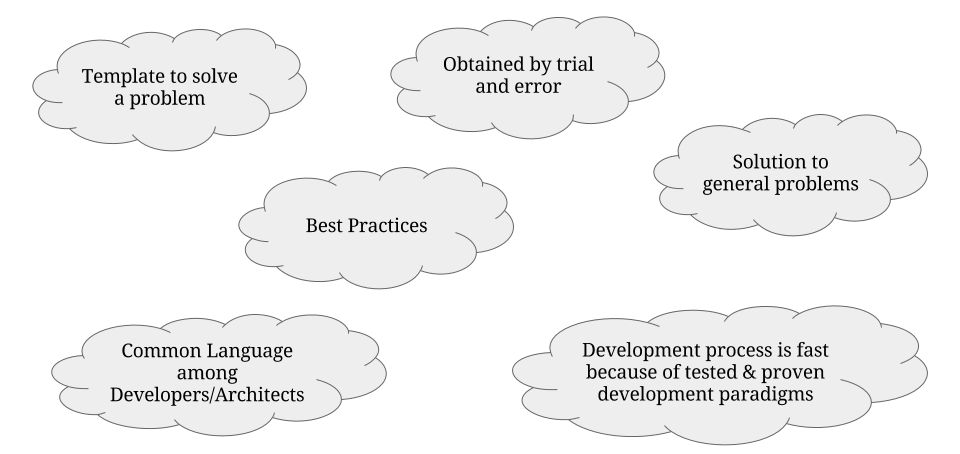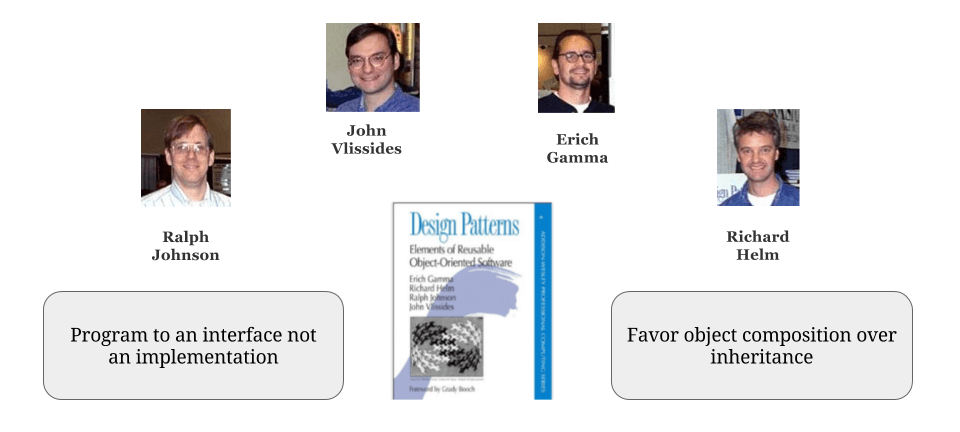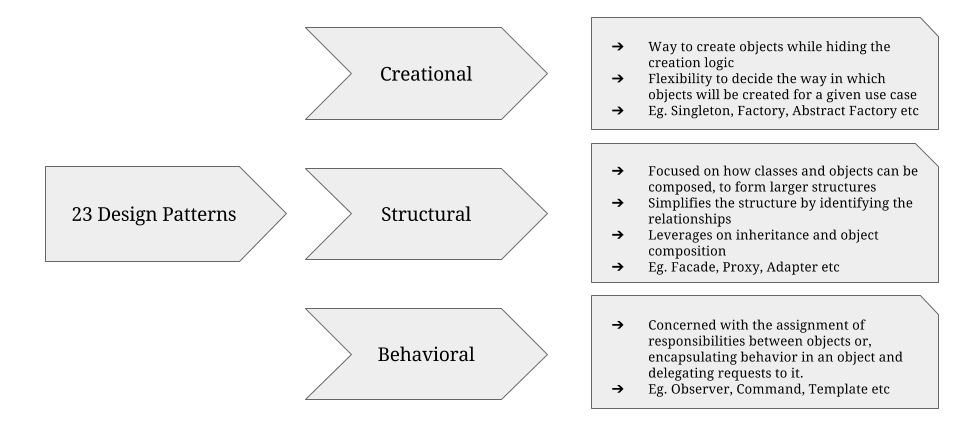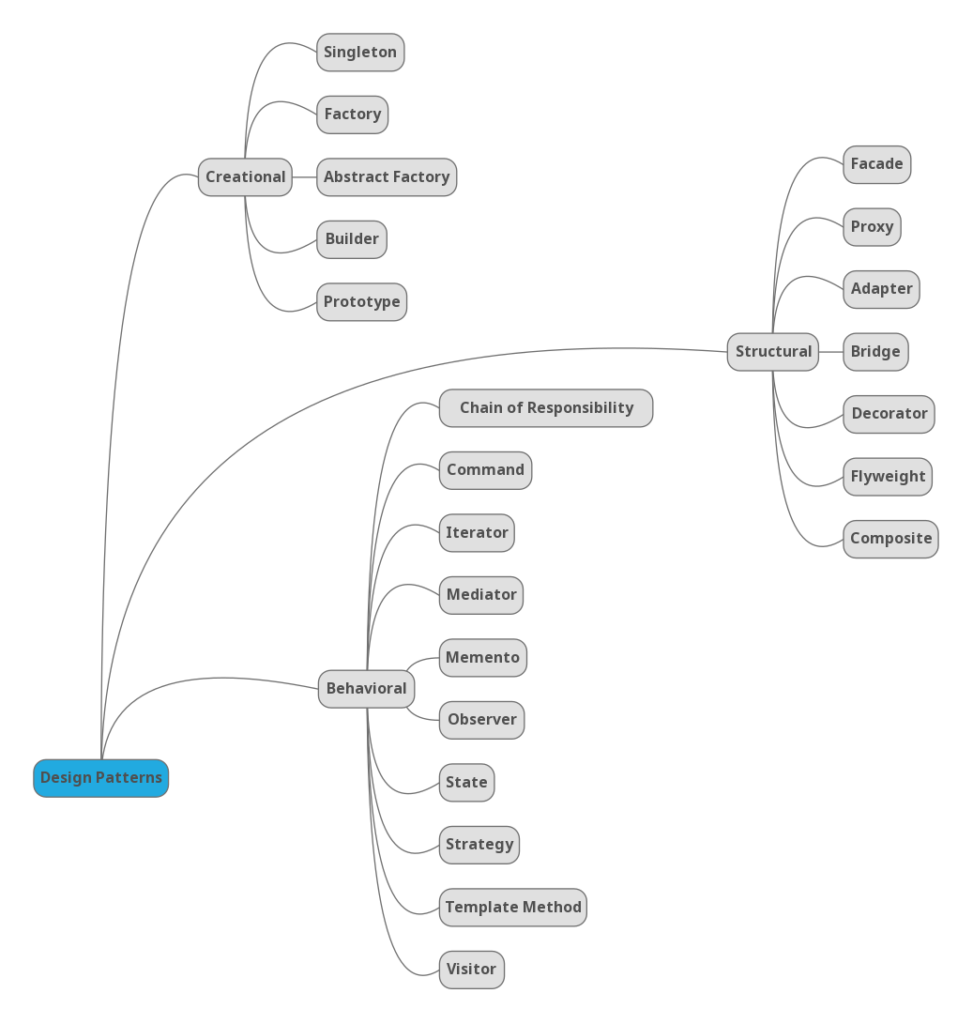Design patterns are obtained by trial and error. They are the solution to generic problems or in other words, they provide a template to solve a problem. Design patterns are the best practices that are used industry-wide. It makes the software development process fast because of tested & proven development paradigms. We can presume Design Patterns as a common language between developers and architects.
What are Design Patterns?

Gang of Four (GOF)

The below four authors of the book “Design Patterns: Elements of Reusable Object-Oriented Software” are often referred to as the Gang of Four (GOF). The authors’ names are Erich Gamma, Richard Helm, Ralph Johnson, and John Vlissides
Advantages of using Design Patterns
- Increased code reuse: When you use a design pattern, you are essentially reusing code that has already been written and tested by someone else. This can save you a lot of time and effort, as you don’t need to reinvent the wheel.
- Improved readability and maintainability: Design patterns can help to make your code more readable and maintainable by providing a common vocabulary and set of conventions. This can make it easier for other developers to understand your code, and it can also make it easier for you to come back to your code later and make changes.
- Increased flexibility and adaptability: Design patterns can help to make your code more flexible and adaptable to change, by providing a framework for building reusable components. This can be important in today’s rapidly changing software development environment, where requirements are constantly changing.
- Reduced risk of bugs: Design patterns can help to reduce the risk of bugs in your code, by providing well-tested solutions to common problems. This can save you time and money in the long run, as you won’t have to spend as much time debugging your code.
- Improved communication: Design patterns can help to improve communication between developers, by providing a common language for discussing software design. This can be helpful when working on large projects with multiple developers, as it can help to ensure that everyone is on the same page.
Overall, design patterns can be a valuable tool for improving the quality, reliability, and maintainability of your software.
Design Pattern Classification & Usage

There are 23 design patterns that have been classified into three main categories based on their area of usage. Those are Creational, Structural & Behavioral patterns. You can get an exact idea of the area of usage from the below diagram/picture.

Creational Design Patterns
Creational design patterns are design patterns that deal with object creation mechanisms, trying to create objects in a manner suitable to the situation. The basic form of object creation could result in design problems or in added complexity to the design. Creational design patterns solve this problem by somehow controlling this object creation.
There are many different creational design patterns, but some of the most common ones include:
- Factory Method: This pattern provides an interface for creating objects in a superclass, but allows subclasses to alter the type of objects that will be created.
- Abstract Factory: This pattern lets you produce families of related objects without specifying their concrete classes.
- Builder: This pattern lets you construct complex objects step by step.
- Prototype: This pattern lets you copy existing objects without making your code dependent on their classes.
- Singleton: This pattern lets you ensure that a class has only one instance while providing a global access point to this instance.
Creational design patterns can be used to improve the flexibility, reusability, and maintainability of software. They can also help to reduce the complexity of object-oriented code.
Here are some of the benefits of using creational design patterns:
- Flexibility: Creational design patterns can help to make the software more flexible by decoupling the creation of objects from their use. This makes it easier to change the types of objects that are used in an application, without having to change the code that uses them.
- Reusability: Creational design patterns can help to make the software more reusable by encapsulating the logic for creating objects. This makes it easier to reuse the code that creates objects in different parts of an application.
- Maintainability: Creational design patterns can help to make the software more maintainable by reducing the complexity of object-oriented code. This makes it easier to understand and modify the code that creates and uses objects.
Structural Design Patterns
Structural design patterns are concerned with how classes and objects can be composed to form larger structures. They simplify the structure by identifying the relationships between classes and objects. Structural design patterns are often used to solve problems related to code reuse, flexibility, and efficiency.
Here are some of the most common structural design patterns:
- Adapter pattern – Allows objects with incompatible interfaces to collaborate.
- Bridge pattern – This lets you split a large class or a set of closely related classes into two separate hierarchies—abstraction and implementation—which can be developed independently of each other.
- Composite pattern – This lets you compose objects into tree structures and then work with these structures as if they were individual objects.
- Decorator pattern – Dynamically adds new responsibilities to an object.
- Facade pattern – Provides a simplified interface to a library, a framework, or any other complex set of classes.
- Flyweight pattern – This allows you to use a limited number of objects to represent a large number of similar objects.
- Proxy pattern – Provides a surrogate or placeholder for another object.
Structural design patterns are a valuable tool for software developers. They can help you to write more reusable, flexible, and efficient code.
Behavioral Design Patterns
Behavioral design patterns are concerned with the interaction between objects. They define how objects communicate with each other and how they coordinate their activities. Behavioral design patterns are often used to solve problems related to code reuse, flexibility, and efficiency.
Here are some of the most common behavioral design patterns:
- Chain of responsibility pattern – This allows you to pass requests along a chain of handlers.
- Command pattern – Turns a request into a stand-alone object that contains all information about the request.
- Interpreter pattern – Defines a language and a grammar for that language, and then interprets sentences in that language.
- Iterator pattern – This lets you traverse elements of a collection without exposing its underlying representation (list, stack, tree, etc.).
- Mediator pattern – This lets you reduce chaotic dependencies between objects.
- Memento pattern – This lets you save and restore the previous state of an object without revealing the details of its implementation.
- Observer pattern – This lets you define a subscription mechanism to notify multiple objects about any events that happen to the object they’re observing.
- State pattern – This lets an object alter its behavior when its internal state changes. It appears as if the object changed its class.
- Strategy pattern – Defines a family of algorithms, puts each of them into a separate class, and makes their objects interchangeable.
- Template method pattern – Defines the skeleton of an algorithm in the superclass but lets subclasses override specific steps of the algorithm without changing its structure.
- Visitor pattern – Lets you separate algorithms from the objects on which they operate.
Behavioral design patterns are a valuable tool for software developers. They can help you to write more reusable, flexible, and efficient code.
Identifying the correct usage of correct design patterns during the design phase of the SDLC is the most sought in the IT industry. The right usage of design patterns makes your product more stable, robust, and scalable.
Further Readings
- https://en.wikipedia.org/wiki/Design_Patterns
- Check out our other blogs on Design Patterns
- Singleton Design Pattern in Java (Code & Illustration) and It’s Challenges
If you are interested in learning more about design patterns, check out the following books:
- The GoF Design Patterns book by Erich Gamma, Richard Helm, Ralph Johnson, and John Vlissides
- The Design Patterns Catalog by Martin Fowler
- The Pragmatic Programmer’s Guide to Design Patterns by Andrew Hunt and David Thomas
- Head First Design Patterns by Eric Freeman and Elisabeth Robson
Feel free to share your thoughts on this topic in the comments section below 👇 We would be happy to hear and discuss the same 🙂





4 thoughts on “Design Patterns: The Secret to Writing Better Code”
Very informative. Please blog on SOLID design principles.
Thanks Nik! Will post soon on SOLID design principles.
Here you go – https://webfuse.in/blogs/a-simple-guide-to-solid-design-principle/ Hope you enjoy it.
Thank You !